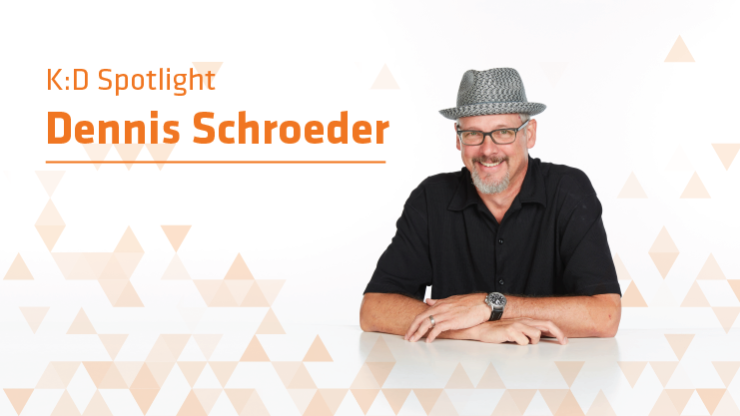
K:D Spotlight: Dennis Schroeder, Product Architect
 We’re excited to introduce the first article in our new series K:D Spotlight where we’ll individually highlight our eclectic and talented group of designers, researchers, strategists and engineers.
We’re excited to introduce the first article in our new series K:D Spotlight where we’ll individually highlight our eclectic and talented group of designers, researchers, strategists and engineers.
Half engineer, half designer, Dennis Schroeder is responsible for ensuring a high quality deliverable, complete with elegant details and appropriate manufacturing. We asked Dennis to shed more light on his dynamic role at Karten Design and share some insightful tips he’s learned from working in the design world for nearly 30 years.
How long have you been with Karten Design and can you elaborate more on your role?
I have the distinction of being Karten Design’s longest full-time employee at nearly 26 years. I can even remember the days when we only had three employees when we first started out. As you can imagine, in 25 years I’ve done everything here at Karten Design. I am trained as an industrial designer and studied engineering all before I started design school. As Karten Design’s Product Architect, I consider my role very unique since I work to ensure that deliverables look good on one end and make sure they work properly on the other end, and everything in between.
What project(s) are you most proud of?
There have been so many projects over the years that I’ve worked on but I think our work on the Axonics Neuromodulation System and Vessix Renal Denervation System stands out the most to me. We had the pleasure of working with the same client for both of these projects. It was great to work with a client who trusted us and gave us free range for us to do what we needed to do. I’m particularly proud of my initial concept work for the Vessix Renal Denervation System and being involved all the way through the execution and production phases.
What’s the most gratifying part of your job?
The prospect of learning new things every day is a very exciting. For example, having worked on numerous medical projects allowed me to learn more about biology and chemistry. I think that’s one of the main reasons why I keep doing what I’m doing; I like creating things and finding creative solutions to problems.
What’s one piece of design advice that you would give?
I think there’s tremendous value in looking at the big picture regardless of the problem you’re encountering. I think it’s easy to get mired down into the specifics without taking a step back and looking at the bigger picture. Details are incredibly important but if you consider them without looking at the whole picture then that can become problematic. I’m the first person to say that I’m very detailed oriented but I can see the value of taking a step back and analyzing a project from a high level.
Can you elaborate more on your working process?
As typical of a designer, you never stop thinking about a project. The ideas you have are constantly swimming around in your head even after the workday ends. It’s not out of the ordinary for me to have that “aha” moment after I see or read something that reminds me of what I’m working on. Additionally, collaboration with colleagues here at Karten Design is very important. I don’t mind explaining to people what projects I’m working on because I find that it helps me in the design process.
What projects are you currently working on?
I’m currently working on developing neurostimulation implants for migraine relief in addition to a Transcatheter Aortic Valve Implantation (TAVI) heart valve delivery system. I’m also finishing up an electronic program guide for the Axonics Neuromodulation System.
How do you see your role as a designer changing five years from now?
I think in order to answer that I have to mention that I first see myself as a problem solver. The problems will change, the answers to those problems will change, but in the end you’re still going to need somebody who will be able to tackle those problems. So, I think there will always be a role for what we do as a company and what we do as individuals because we have a unique way of looking at those things in order to come up with the answers.
If you weren’t working for Karten Design, what do you think you would be doing?
No matter what, I know that I would be off creating something, somewhere, somehow. Oddly enough, I was recently at a winery in Napa Valley and I was amazed learning about the work involved in producing wine barrels. The assembly process and responsibility needed to be a barrel maker was something I found astounding. Something in that moment made me want to move straight to the south of France and be a wine barrel maker!





